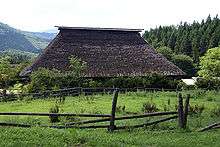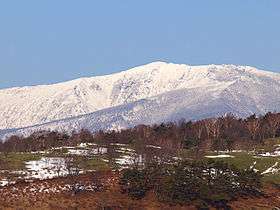Tōno, Iwate
| Tōno 遠野市 | |||
|---|---|---|---|
| City | |||
|
Tōno City | |||
| |||
 Location of Tōno in Iwate Prefecture | |||
 Tōno
| |||
| Coordinates: 39°19′0.4″N 141°32′0.1″E / 39.316778°N 141.533361°ECoordinates: 39°19′0.4″N 141°32′0.1″E / 39.316778°N 141.533361°E | |||
| Country | Japan | ||
| Region | Tōhoku | ||
| Prefecture | Iwate | ||
| Government | |||
| • -Mayor | Toshiaki Honda | ||
| Area | |||
| • Total | 825.97 km2 (318.91 sq mi) | ||
| Population (September 2015) | |||
| • Total | 27,672 | ||
| • Density | 33.5/km2 (87/sq mi) | ||
| Time zone | Japan Standard Time (UTC+9) | ||
| - Tree | Spreading Yew | ||
| - Flower | Lilium auratum | ||
| - Bird | Copper pheasant | ||
| Phone number | 0198-62-2111 | ||
| Address | 8-12 Higashidate-chō, Tōno-shi 028-0592 | ||
| Website | Official website | ||

Tōno (遠野市 Tōno-shi) is a city located in Iwate Prefecture, in the Tohoku region of northern Japan. As of September 2015, the city had an estimated population of 27,672 and a population density of 33.5 persons per km². The total area was 825.97 square kilometres (318.91 sq mi). Tōno is known as "The City of Folklore" for its rural nature, its preservation of traditional culture and especially for the collection of folktales, Tōno Monogatari, written by Kunio Yanagita in 1910.
Overview
The city has a number of sightseeing spots, such as Kappabuchi, a pool where the mythical creatures called kappa are said to live. Tōno Furusato Village preserves several magariya, or L-shaped houses, from the 18th and 19th centuries. The Chiba Family House is another large magariya that is preserved in Tōno as a museum.
Tōno's food includes Genghis Khan or barbecued lamb and hittsumi or wheat dumplings as well as horse meat. The Miyamori part of Tōno is known for its wasabi production and a local brewery makes a wasabi beer.
Festivals include the Tōno Folktales Festival in early February, in which local storytellers recite stories from the Tōno Monogatari. The Tōno Tanabata Festival is held in early August and features a parade of dancers through the city center. In mid-September is the Tōno Festival which also features a parade and yabusame or horseback archery.
Geography
Tōno is located in central Iwate Prefecture, in the floodplain of the Sarugaishi River, surrounded by a ring of mountains. Mount Hayachine sits at the northernmost point of the city where Hanamaki, Kawai and Tōno meet. At 1,914 meters it is also the city's highest point. Mt. Rokkoushi, (1,294 meters) dominates the landscape to the east and Mt. Ishigami (1,038 meters) is the highest mountain in the west. Together these peaks form Tōno's "big three" mountains. The highest points in southern Tōno are Mt. Sadato (884 meters) on the border of Sumida and Mt. Tane (871 meters) on the borders of Sumita and Ōshū.
Accordingly, to legend, in the past the hills in Miyamori blocked the Sarugaishi River creating a large lake in the Tōno area. Miyamori itself is characterized by a series of valleys to the west of Mt. Ishigami that flow west into the Sarugaishi River just below the Tase Dam.
Neighboring municipalities
- Iwate Prefecture
History

The area of present-day Tōno was part of ancient Mutsu Province, and has been settled since at least the Jōmon period. Pottery fragments can still be easily found in farmers' fields and other places. Later the area was inhabited by the Emishi and many place names are still in the Ainu language. In the Zenkunen, or Early Nine-Years War lasting from 1051 to 1063, Minamoto no Yoshiie fought running battles with Abe no Sadato throughout the area. There are references to this in "Tōno Monogatari" and arrowheads still turn up from time to time.Later the Hiraizumi Fujiwara controlled Tōno which was a prized area for horse breeding, farming and hunting.
During the Sengoku period, the area was dominated by various samurai clans before coming under the control of the Nambu clan during the Edo period, who ruled Morioka Domain under the Tokugawa shogunate. The Nambu built Nabekura Castle in what is now known as Nabekura Park in downtown Tōno. The castle was completed in 1627 and occupied by a branch of the Nanbu clan from Hachinohe as a subsidiary 12,500 koku domain.
In the Meiji period, Tōno developed a silk and cotton weaving industry dependent on Morioka. The silk industry was destroyed by intensely cold weather during the winter of 1905-06. The residents of Tōno were reduced to eating wild roots by the famine of this period and many died or moved away.
The modern city of Tōno was officially founded on December 1, 1954 by the merger of the former town of Tōno with the seven villages of Ayaori, Otomo, Tsukimoushi, Matsuzaki, Tsuchibuchi, Aozasa and Kamigo.
On October 1, 2005, the village of Miyamori (from Kamihei District) was merged into Tōno.
Education
There are two senior high schools in Tōno, under the purview of Iwate's Prefectural Board of Education. Iwate Prefectural Tōno Senior High School offers an academic curriculum, while Iwate Prefectural Tōno Ryokuhō Senior High School is vocational.
As of 2012, the city operated three junior high schools: Tōno, Tōno-Higashi, and Tōno-Nishi.
The city also operates 11 elementary schools: Aozasa, Ayaori, Kamigō, Masuzawa, Miyamori, Otomo, Tassobe, Tōno, Tōno North, Tsuchibuchi, and Tsukimoushi.
Transportation
Railway
- East Japan Railway Company (JR East) – Kamaishi Line
- Iwanebashi - Miyamori - Kashiwagidaira - Masuzawa - Arayamae - Iwate-Futsukamachi - Ayaori - Tōno - Aozasa - Iwate-Kamigō - Hirakura - Ashigase
Highway

Local attractions
Culture
The entire city can be considered a sightseeing attraction in itself considering the number of places mentioned in Tōno Monogatari. Besides the promoted attractions there are still many ordinary houses and other buildings throughout the area left over from a bygone era.
Locations
- Tōno Furusato Village - is collection of magariya type houses from the 18th and 19th centuries that have been relocated to this site. There are seasonal events and entertainments provided during peak vacation times. There is also a restaurant, gift shop, library and museum of natural history.
- Chiba Family Nanbu Magariya - is a large 200-year-old farmhouse which is still occupied but open for tourists as well.
- Denshoen - is a group of buildings including the Kikuchi Family Magariya and the Sasaki Kizen Memorial Museum. The Oshirado Hall enshrines 1,000 Oshira-sama deities.
- Tōno Castle Town Materials Museum - is dedicated to preserving artifacts from the Nanbu clan when Tōno was a prosperous castle town. There are kimono, netsuke, swords and so forth on display.
- Fukusen-ji Temple - is a Shingon Buddhist temple housing the largest wooden Kannon statue in Japan. The grounds of the temple are quite extensive and have many buildings including a five story pagoda.
- Tōno Kura no Michi Gallery - is a collection of old "kura" or storehouses that have been made into an art gallery, gift shop and toy museum.
- Kappabuchi - is a pool behind Joken-ji Temple which is said to be the home of many "kappa" or mythical water sprites.
- Denderano - is a hut far from any houses where the elderly were brought to die in ages past, for they were seen by their children as no longer productive. The landscape where the huts were is called Dendera Field.[1]
- 500 Buddhist Disciples - are a group of carvings on granite rocks done by a priest of Daiji-ji Temple to commemorate the victims of a famine.
- Arakawa-kōgen Farm - an Important Cultural Landscape[2]
Events
- Tōno Folktales Festival - in early February - in which storytellers recite tales from Tōno Monogatari.
- Tōno Machiya Doll Festival - from late February through early March - in which traditional dolls are displayed in shops and museums throughout the city.
- Tōno Cherry Blossom Festival - in early May - in which the cherries bloom and everyone parties under the blossoms.
- Tōno Horsepower Tournament - on the 4th Sunday in June - in which draft animals compete in pulling heavy loads.
- Manuke-bushi Festival - in early August - is a humorous dance held on the streets of Tōno.
- Tōno Tanabata Festival - in early August - is a dance and parade that starts in front of the station and goes through the city.
- Tōno Fireworks Festival - on August 15 - is fireworks.
- Tōno Festival - in mid-September - is another dance and parade through the city streets celebrating the harvest.
- Tōno Dobekko Festival - every weekend from late November to early March - is a chance to drink moonshine legally.
Folklore

Tōno is known throughout Japan as the cradle of Tōno Monogatari (Tales of Tōno), written in 1910 by Kunio Yanagita, who gathered folk tales of the area. This book is now considered one of the greatest studies of Japanese folklore, and inspired the 1982 movie of the same name.
Several of these tales involve the Kappa, mischievous water sprites. A legendary location in Tōno is the Kappa-buchi, a water stream where kappas are said to live.
The mascot of the city, Karin-chan, is a cute kappa holding a bellflower. She is usually depicted walking in front of a Magariya.
International relations
Tōno is also twinned with three Japanese cities:
- Mitaka, Tokyo, since 1989
- Musashino, Tokyo, since 1988
- Kikuchi, Kumamoto, since 1998
From 1990 to 2010, the high schools of Tōno and the Chattanooga School for the Arts & Sciences (CSAS) in Chattanooga, Tennessee were paired by School Partners Abroad to establish an exchange program. Near the end of every Japanese school year (in March), a delegation of Tōno high-school students visited Chattanooga, and reciprocally, a delegation from CSAS visited Tōno every summer. The city of Tōno embraced this exchange and organized a delegation of junior high school students to visit CSAS and the Chattanooga School for the Liberal Arts (CSLA) a few weeks before the high school students.
Noted people from Tōno
- Inō Kanori – anthropologist
- Shinkichi Kikuchi – professional soccer player
- Toshimi Kikuchi – professional soccer player
- Kuniko Koda – politician
- Kizen Sasaki – folklorist
References
- ↑ "The Films of Abraham Ravett: Horse/Kappa/House". Hampshire College. 2009. Retrieved 26 July 2012.
- ↑ "Database of Registered National Cultural Properties". Agency for Cultural Affairs. Retrieved 29 April 2011.
- ↑ "International Exchange". List of Affiliation Partners within Prefectures. Council of Local Authorities for International Relations (CLAIR). Retrieved 21 November 2015.
External links
![]() Media related to Tōno, Iwate at Wikimedia Commons
Media related to Tōno, Iwate at Wikimedia Commons
- Official website (Japanese)


